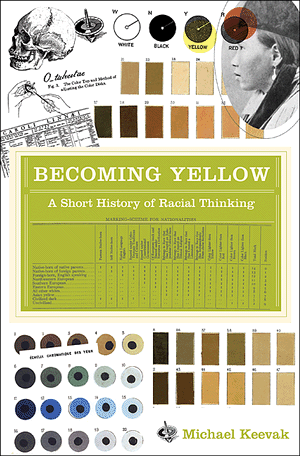Becoming Yellow: A Short History of Racial Thinking by Michael Keevak (review)
China Review International
Volume 19, Number 1, 2012
pages 103-105
DOI: 10.1353/cri.2012.0023
Paul Spickard, Professor of History
University of California, Santa Barbara
Michael Keevak, Becoming Yellow: A Short History of Racial Thinking (Princeton: Princeton University Press, 2011). 248 pages.
Becoming Yellow is a smart, erudite, intriguing, quirky, delightful, and ultimately unsatisfying book. Michael Keevak sets out to trace how, from the sixteenth century to the nineteenth, the skin color of East Asians changed from white to yellow in the minds of Europeans and how all East Asians came to be viewed as members of a single Mongolian race. His larger purpose may be to comment on the broader history of European racial thinking and, perhaps, to displace whiteness and blackness from the core of that story, although he never quite articulates that intent.
Keevak traces the ideas of some familiar racial thinkers: Linneaus, Blumenbach, Buffon, Cuvier, Broca, Gobineau, and Davenport. He also gives us a taste of the ideas of a lot of writers whose racial ideas have remained hidden to all but the most diligent scholars—people such as Giovanni da Empoli, Duarte Barbosa, Juan González de Mendoza, Karl Gützlaff, François Bernier, Johann Christian Polykarp Erxleben, G. S. Mellin, James Cowles Prichard, Carl Gustav Carus, and dozens of others.
The main outlines of Keevak’s book are clear. Becoming Yellow begins with an introduction that gestures toward several topics that will be treated later in the book. There follows a chapter on how the skin and character of East Asians were perceived by European scholars and missionaries in the sixteenth and seventeenth centuries. These are followed by an account of how Linnaeus, Blumenbach, and their eighteenth-century contemporaries arrived at yellow as the color that would stand for East Asians, and how they decided that Mongolians were the core people in East Asia. Then follows a chapter on the rise of anthropometry in the nineteenth century and the measurement of so-called Mongolians’ skull shapes, skin color, and the like. The next chapter focuses on the fascination of nineteenth-century Western medicine with Asian bodies—the so-called Mongolian eyefold, the Mongolian spot, Mongolism, and so on. The final chapter is a hodge-podge that briefly describes the turn-of-the-century Western political movement fed by fear of invasion by a “yellow peril.” It outlines the very different responses of Chinese and Japanese writers to Western ideas about Asian skin color and attempts to sum them up.
Keevak has a curious manner of pursing an argument. Despite the fairly clear overall arc of the book, each chapter is quite muddled internally. Keevak tends, early in each chapter, to refer, without explanation or context, to key ideas that he has not introduced (but, it turns out, may develop later). This approach suggests that the reader and author had already discussed the issue, so he does not have to establish or articulate its significance. The narrative in each chapter whirls around its subject, feinting here and there, rather than proceeding in a linear fashion. Keevak offers lots of esoteric details, all dutifully footnoted. He presents them by way of illustrating points, rather than as proof that his points are true. Even so, his knowledge is impressive. Then, when he comes to the major assertions in each chapter’s argument, there are no notes at all, and everything proceeds at the level of naked assertion. It is as if Keevak is displaying all his minute and intricate learning early on, so that we will believe him later, when he makes, unsupported, the key parts of his argument.
Nonetheless, many of his ideas are arresting, even if unsupported. To take just one example, Keevak concludes that “yellow began as a way of emphasizing Chinese proximity to Europeans . . . but . . . over time it had become redeployed as a term of complexional distance” (p. 34). This assertion might be true, though Keevak does not really demonstrate it, much less prove it.
Despite the shortcomings of his approach, each chapter is, nonetheless, quite delightful if one can let go of the need for linear arguments undergirded by solid supporting evidence. Keevak is so learned about odd esoterica that the reader can sit back and just enjoy the details. In each chapter Keevak presents a lovely collection—a bit like John Soane’s house on Lincoln Inn’s Fields in London—of overstuffed rooms of ephemera, all jumbled together, each of interest individually…

